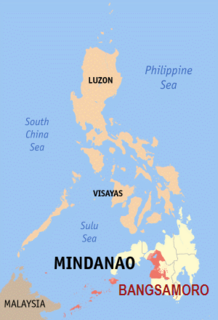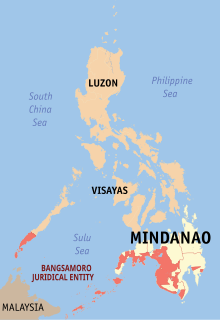
The Moro Islamic Liberation Front is a group based in Mindanao, Philippines, seeking an autonomous region of the Moro people from the central government. The group has a presence in the Bangsamoro region of Mindanao, the Sulu Archipelago, Palawan, Basilan, and other neighbouring islands.

The Communist Party of the Philippines is a far-left, Marxist-Leninist-Maoist revolutionary organization and communist party in the Philippines, formed by Jose Maria Sison on 26 December 1968. It is designated as a terrorist group by the United States Department of State through Executive Order No. 13224 together with Sison and the New People's Army (NPA) in 2002. The European Union, through Council Decision (CSFP) 2019/1341, renewed the terrorist designation of the CPP-NPA in 2019, though the European Union's second highest court ruled in September 2009 to delist Sison as a "person supporting terrorism" and reversed a decision by member governments to freeze assets. According to the US' Central Intelligence Agency (CIA) World Factbook, the CPP and its armed wing, the NPA, aims to destabilize the Philippines' economy and overthrow the national government.

The Moro people or Bangsamoro people are the 13 Muslim-majority ethnolinguistic Austronesian groups of Mindanao, Sulu, and Palawan, native to the region known as the Bangsamoro. As Muslim-majority ethnic groups, they form the largest non-Christian population in the Philippines, and comprise about 5% of the country's total population, or 5 million people.

The National Democratic Front of the Philippines (NDFP) is a coalition of revolutionary social and economic justice organizations, agricultural unions, trade unions, indigenous rights groups, leftist political parties, and other related groups in the Philippines. It belongs to the much broader National Democracy Movement and the communist rebellion in the Philippines.

The Moro National Liberation Front is a political organization in the Philippines that was founded in 1972. It started as a splinter group of the Muslim Independence Movement. The MNLF was the leading organization among Moro separatists for about two decades beginning from the 1970s.

The ongoing communist rebellion in the Philippines is a conflict between the government of the Philippines and the New People's Army (NPA), which is the armed wing of the Marxist–Leninist–Maoist Communist Party of the Philippines (CPP). The conflict is also associated with the National Democratic Front of the Philippines (NDFP), which serves as the political wing of the CPP.

The Moro National Liberation Front Executive Council of 15 is a faction of the Moro National Liberation Front (MNLF) in which the group of 15 leaders forged a unity agreement with the Moro Islamic Liberation Front (MILF). The agreement was signed in Kuala Lumpur and coincided with the Filipino President's visit. Muslimin Sema is the current chairman of the group. The government of the Philippines recognizes Sema along with Misuari as representatives of the MNLF despite the recognition of Nur Misuari as chairman by the Organisation of Islamic Cooperation, which the MNLF is an observer member to. Supposedly, Sema's group together with Habib Mudjahab Hashim's MNLF Islamic Command Council (ICC), somewhat agreed to reunite with the MNLF under Misuari.

Dimasangcay Pundato a Muslim Filipino of Maranao descent, known to friends and kin as "Kumander Dimas", was former Moro revolutionary leader and undersecretary of the Office of the Presidential Adviser on the Peace Process. He served for nine years in the now-defunct Office on Muslim Affairs (OMA) under the Office of the President during the administrations of the late President Cory Aquino and former President Fidel V. Ramos. He was Vice Chairman of the Moro National Liberation Front (MNLF) and Chairman of the MNLF Reformist Group, where he negotiated with the Ramos administration in peace talks with Moro rebel front leaders.
In the late 1960s, an independence movement was founded in Mindanao, the Philippines to separate the Muslim majority-Moro areas from the rest of the Philippines.

Bangsamoro, officially the Bangsamoro Autonomous Region in Muslim Mindanao, is an autonomous region located in the southern Philippines.

The Comprehensive Agreement on Bangsamoro (CAB) is a final peace agreement signed between the Government of the Philippines and the Moro Islamic Liberation Front on March 27, 2014 at the Malacañang Palace in Manila. Under the agreement, the Islamic separatists would turn over their firearms to a third party, which would be selected by the rebels and the Philippine government. The MILF agreed to decommission its armed wing, the Bangsamoro Islamic Armed Forces (BIAF). In return, the government would establish an autonomous Bangsamoro. Power sharing was a central point to the autonomy redesign.

Mohagher Iqbal is the nom de guerre of the member of the Moro Islamic Liberation Front who serves as chair of the group's peace panel.

The 1976 Tripoli Agreement was signed on December 23, 1976 in Tripoli, Libya by Carmelo Z. Barbero, representing the Government of the Philippines and Nur Misuari of the Moro National Liberation Front. The agreement defined autonomous administrative divisions for Muslims in the southern Philippines, the establishment of an autonomous government, judicial system for Sharia law and special security forces, and the observance of a ceasefire. The autonomous region was to have its own economic system, including an Islamic bank.

The Jeddah Accord was signed on January 3–4, 1987 in Jeddah, Saudi Arabia by Aquilino Pimentel Jr., representing the Government of the Philippines and Nur Misuari of the Moro National Liberation Front. The two panels agreed upon the continued discussion of the proposal of the grant of full autonomy to Mindanao, Basilan, Sulu, Tawi-Tawi and Palawan subject to democratic processes.
The 1996 Final Peace Agreement, also called the Jakarta Accord was signed on September 2, 1996 in Manila, Philippines by Manuel Yan, representing the Government of the Philippines and Nur Misuari of the Moro National Liberation Front. The culmination of four years of peace talks, the agreement established mechanisms designed to bring about the full implementation of the 1976 Tripoli Agreement.

The Cordillera autonomy movement in the Philippines refers to the campaign for greater autonomy for the Cordilleras.
Dickson Peñas Hermoso is a Filipino government official and former military official who serves as the head of the Ministry of Transportation and Communications of Bangsamoro. He was also known for being part of the Philippine Army's 6th Infantry Division which was involved in the Moro conflict.

The National Task Force to End Local Communist Armed Conflict (NTF-ELCAC) is a task force organized by the government of the Philippines to respond and raise awareness to the ongoing communist rebellion in the Philippines.

The Bangsamoro Juridical Entity (BJE) was a proposed subdivision in the Philippines spanning portions of Mindanao and Palawan. Conceptualized during the peace talks between the government of the Philippines during the administration of President Gloria Macapagal Arroyo and the Moro Islamic Liberation Front (MILF), the BJE was the proposed expanded successor to the Autonomous Region in Muslim Mindanao (ARMM).

The 1989 Autonomous Region in Muslim Mindanao creation plebiscite was a creation plebiscite held on November 17, 1989 in parts of Mindanao and Palawan in the Philippines.















